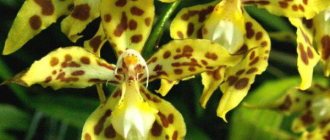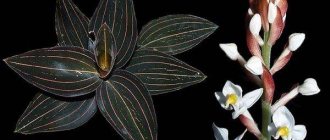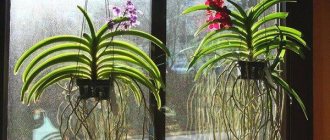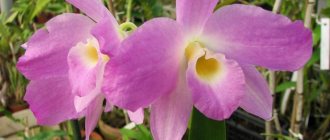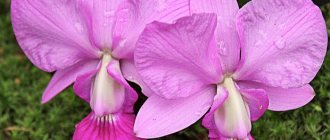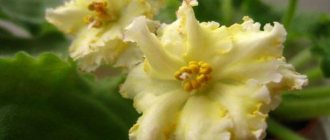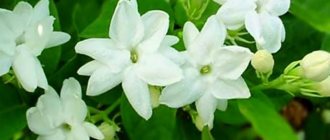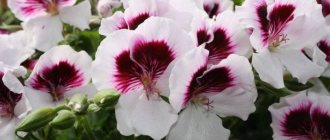Fragile and sophisticated, the zygopetalum orchid is still little known to orchid growers living in the temperate latitudes of Eastern Europe. And it is completely unclear why - caring for it at home is not much different from keeping the same cymbidiums or cattleyas, and the environmental conditions are quite suitable for those in which most indoor flowers live.
The plant's obscure name, zygopetalum, refers to the structure of the flower and is translated from Greek as “petal to petal.” The sepals and petals of the corolla of the zygopetalum are fused at the base and connected by a narrow bridge. And the orchid received its poetic epithet due to the characteristic shape of the lip, which in almost all species has white-bluish-lilac shades and looks like the fluttering wings of a flying angel.
In nature, zygopetalums live in Central and South America, but most of the 14 officially registered species grow in Brazil as epiphytes of moist forests in river valleys and on the slopes of small plateaus, although there are also those that lead a terrestrial lifestyle or choose rock ledges for their existence .
Description and distinctive features
Let's take a closer look and find out what the Zygopetalum orchid looks like: description and care at home:
- In the genus Zygopetalum only 15 types. The translation doesn't explain much. They are like “connecting sepals.” These are not like butterflies;
The Zygopetalum orchid is a very beautiful and rare flower. - Even experts consider this species to be rare ;
- If you like detective stories. Nero Wolf mentions this plant in his works. Here she is “Miss Tropics”. Flexible and curved;
- Experts are more inclined to believe that this type of orchid is rather capricious . And they add. As in the whole family, there are no simple ones.
Consider the plant itself:
- It is formed in the form of a ladder escape. And in the pot there seems to be a nest of several pseudobulbs. New ones appear a little above and to the side of the old ones. What is a pseudobulb : Orchid stems thickened at the bottom;
- Green, smooth, elliptical (oval) shaped formation;
- 6-7 cm long (height). Flattened.
Please note! Flower shops OBI and IKEA will most likely offer you interspecific hybrids - Zygonisia, Zygolum .
Appearance and photo
The following parameters will help you give a detailed description of the flower:
- Stem . Creeping, grows like a ladder. The shoots are tall, reaching a height of 50-60 cm. Pseudobulbs are short, 5-6 cm long, bright green, compacted.
- Leaves . Shiny, leathery, glossy. Wide, pointed at the edge. The plates have longitudinal veins.
- Flowers . The peduncle is straight, 45-50 cm long, formed from the lower leaves. The inflorescences are racemes. They form up to 12 buds. The flowers are variegated, spotted, of various shades - green, purple, white. They come in one color. The lip is contrasting, large, bright purple or lilac.
- Roots . Dense but fragile. The shoots are white, dense, and grow in a spiral.
Reference . If you properly care for your orchid, it will form the maximum number of buds. At the same time, the flowers will be distinguished by their large size, pleasant subtle aroma, and incredibly rich shades.
For more detailed information, below are photos of the flower.
Varieties of Zygopetalum orchid
Mackay
- The most famous . Maybe popular;
- His mistresses consider him the most beautiful ;
- Still would. White lip with purple or reddish lines and dots;
- Very often used for breeding new varieties . With her participation there are already more than 20 of them.
Zygopetalum mackaii.
Also Mackay.
Maxillare. Zygopetalum maxillare
- The violet color disperses evenly into a faint violet tint towards the edges of the lip;
- The length of the peduncle reaches 35 cm . Each has 6-8 flowers;
- The burgundy-brown color almost completely covers the green petals at the base.
Z. maxillare.
Blue Angel
Those who saw it in person remembered more than the color. And the aroma. It reminded them of ground black pepper.
Zyg. Rhein Blue Angel.
Luisendorf. Zygopetalum Louisendorf
Very sweet aroma . They even take him out of the bedroom. Ardent lovers of these flowers.
Zig. Louisendorf.
Plant care
Zygopetalum is very easy to care for. This orchid lives in shady and humid tropical forests, so it is enough to create conditions close to natural and occasionally water it. The plant is suitable for partial shade or diffused light from a northern or eastern window. If the leaves of the zygopetalum turn yellow, it means there is not enough light for it and you should move the pot to a more illuminated place or use artificial lighting.
Zygopetalum can exist in a temperature range from +15°C to +25°C. For normal growth, it is important to ensure low temperatures at night. This helps to form flower buds and actively grow shoots.
On cool days, the orchid is quite capable of adapting to the air humidity of a temperate climate, but on intense heat, spraying is recommended. Zygopetalum needs intensive watering in the active phase. Water must drain easily and the soil must dry completely between irrigations. In winter, the frequency of watering is halved.
Zygopetalum gets everything it needs from the soil and atmosphere. Only during the flowering period can mineral fertilizers be applied to orchids. A healthy plant needs only half the dose of fertilizer.
Transplantation is carried out only if absolutely necessary, because any intervention in the root system is a great stress and can cause disease. First, the plant is removed from the pot and freed from the old substrate. If necessary, divide the bulbs and cut off the dried roots. All cut areas are sprinkled with crushed charcoal. For planting, use transparent plastic pots with soil for orchids. The bulbs are placed above the surface of the pot.
Homeland and territory of distribution in nature
The nature of South America has gifted everyone with an amazing plant from the orchid family. The whole genus Zygopetalym (zygupetalum). The tropical rainforests of Brazil, Venezuela and Colombia have the most of them. But they grow:
- In Peru;
- Bolivia;
- Paraguay;
- And Mexico.
For us they are a curiosity. Feels great :
- On the trees;
- Stones;
- Earth.
And it is not a parasite in relation to other plants. In nature, these are epiphytic and lithophytic plants :
These extraordinary orchids grow on trees, rocks and the ground.
- Epiphytes (Greek: “on plants”) are plants that grow or are attached to other plants (trunks or branches). And it does not receive any nutrients . They are not parasitic;
- Lithophytes (from the Greek “stone” and “plant”). Plants that have adapted to life on stones and rocks (dolomite, limestone, marble). There are more of them in the cracks .
Placement in an apartment: requirements for light and temperature
Zygopetalum is unpretentious to lighting conditions. In nature, the orchid grows in the lower layer of the tropical forest, to which the sun's rays rarely reach. In an apartment, windows facing east or west and very bright northern window openings are suitable for it. Bright sunlight causes burns on the leaves and also provokes too early flowering on young shoots.
The leaf blades of the orchid will indicate an excess or lack of illumination of the zygopetalum: their rich, rich green color indicates that the plant is developing under normal conditions, a yellow-light green tint signals that it is urgently necessary to transfer the flower to a place in the apartment where there is good shading from the sun.
The usual temperatures for zygopetalum are moderate or moderately cool. The optimal maximum is 25 degrees Celsius, at night it is advisable to drop to 14–16 degrees. The plant can withstand a short-term drop in the room thermometer to 5 degrees above zero.
Reviews
Natalia. “My story as a florist is similar to many. There were several pots of violets on the windowsill. Even ordinary watering was not part of my duties. I was not puzzled. But she didn’t show any initiative. Growing up, my attitude towards flowers changed. These flowers brought comfort and beauty. And now the collection includes flowers whose names many cannot pronounce correctly. Things don't always work out. There are also miscalculations. Some of them couldn't even be saved.
But there is already solid experience. Including the maintenance and care of orchids. Many friends ask for advice. I'll be happy to explain. After my stories, some people got their own orchids. Fears about complex care are already a thing of the past. More than a dozen phalaenopsis.
And now Zygopetalums have already appeared. They are even easier to care for. What can you grow without desire? And it doesn’t matter that some don’t have names. They are just white, pink, yellow. Such beauty is worth the effort, effort, and money.
So I advise many to put aside doubts about orchids. In reality, everything is much simpler. It is imperative to create the necessary conditions for these beauties. To admire beautiful flowers. It's within your power.
I do not recommend using clay pots. Roots can grow into them. And get damaged during transplants.
I don’t recommend buying and transporting orchids in the cold winter.”
Alexander. “I already have good experience in growing orchids. Almost ten years. There are now much more opportunities to acquire them. Take the Internet, for example. Varieties. Care. Everything for growing them (pots, soil, fertilizers). Detailed care tips. I will note on my own behalf. There are enough contradictory ones. For some they are suitable. I want to share my observations. I water the flowers without immersing the pots in water. I spill it around the edges of the container. Until water flows out of the pot.
I pay special attention to high-quality lighting. There are many flowers. Lights for each shelf. After the store I will definitely replant it. I select convenient containers. I completely replace the soil. I carefully examine the roots. I definitely remove dried and damaged ones.
Now they like to add coconut shavings to the soil. I'm deleting it. And I advise you. The soil must contain fine coniferous bark, peat, perlite and charcoal. Keep in mind. The roots are fragile and break easily. I definitely feed it with humus fertilizers (Gumate-7). 2 times a month. Without this you cannot see flowers.
And remember. The soil should not be allowed to dry completely. They are from the humid tropics."
Marina. “My orchid lovers and I came to the same conclusion. Don't be afraid to buy them. Although not exactly cheap. Our conditions allow us to provide them with conditions for flowering. Of course, we need to take care of this. Reading reviews also helps a lot. There are a lot of people there: “Oh, I bought this beauty. What is this? And what to do next?
But there are a lot of useful tips. Some of my friends place this orchid on loggias in the summer. Even in gazebos. And they bloom! I want to try it myself.
High humidity (about 60%) needs to be constant. And I water it often. Moderately. That's why I ventilate the rooms often. It is necessary to carefully monitor the condition of the soil.
Every month I feed it with humus. Be careful with nitrogen fertilizers. They can burn the roots. How can you determine the condition of the soil. And the need for watering. Root color (grayish). The moisture is gone - the weight is lighter.
About lighting and backlighting. Excessively bright lighting promotes rapid growth of flower stalks. But the pseudobulbs lag behind and do not have time to ripen. This negatively affects the ability to bloom in the future. Low light does not allow them to bloom. We need a golden mean.”
Prevention
- Do not allow water to stagnate in pots.
- Ventilate the room regularly, use only high-quality substrate and seedlings, and maintain lighting conditions.
- If any drugs or growth stimulants are used, follow the manufacturer's instructions.
The Zygopetalum orchid is an interesting and beautiful plant. Even a beginner can grow a wild flower indoors . The florist is required to take into account all the recommendations and advice and be patient. With a competent approach to growing, the orchid will grow strong, and in due time will delight you with beautiful and fragrant flowers.
External characteristics
Florist specialists classify it as a group of horizontally growing plants.
They are called sympodial (from the Greek “together” or “many”):
- This orchid has several growing points. Shoots grow from them and transform into pseudobulbs;
- So they disperse across the width of the pot. Towards its edges, in the photo you can see this;
- United by one rhizome (rhizome);
- From these growths, as it were, 2-4 leaves grow. And a peduncle.
This orchid has several growing points, from which several shoots are formed.
On a note! Pseudobulba lives 2-3 years. Having formed a peduncle and given it the opportunity to bloom, it itself no longer grows. A new shoot usually appears at the base.
The difference between monopodial orchids (phalaenopsis) is that the leaves grow one above the other . And the peduncle grows from the axils of the leaves.
Mature plant height
It must be specified. So that they do not mistakenly think that the orchid is creeping. And choose the appropriate place . And the grown leaves and flower stalks necessarily bend.
Number of leaves
Quite a lot of leaves are formed . Few people count them. But to control the condition of the plant, you need to know. Each pseudobulb produces 2-4 leaves. And the bush looks solid.
Maximum peduncle length
And they grow up to 50 cm with proper care and conditions . There can be up to 8 pieces on perennial plants. And each has 6-10 flowers.
Can you imagine such a bouquet? You will see and believe.
Diameter, flower shape
7-8 cm will be exactly. On the line. If you measure it. The way it is. There is more on the Internet. Especially in the price lists of selling companies and entrepreneurs .
But it's not the size that surprises. And its shape. Five elongated petals of course. But most of all the lip. He even calls it spade-shaped . I prefer the comparison with a fan.
Where can I buy it and its cost?
Zygopetalum orchid seeds are tiny spores, for which it is difficult to create conditions for germination at home; this method is used only in enterprises.
You can buy the plant in flower shops, through online stores or from collectors. This genus of orchids is offered by such companies as Miltonia, Mayflor, Flora, and online stores Buy-orchid.rf, Orhid.22.ru, Bloom-story. They are less common than other types of orchids and often require pre-ordering.
The cost of a plant ranges from 690 rubles to 3000 . It is not recommended to buy one bulb of Zygopetalum, no matter how tempting the price may seem. For planting, it is desirable that the plant have at least three pseudobulbs.
Main features of flowering
Nature is difficult to understand. When does it start to bloom? How long does it bloom? Are there these periods of rest? What does repeated mean? There are a large number of them there. Constant climate . In the tropics, some have just bloomed, while others have already faded. But it blooms on not yet fully formed pseudobulbs.
Period
In an apartment, we create the conditions ourselves . Two blooms per year. And they were accustomed to the intervals between flowerings (dormant periods). This may not be the correct wording.
Duration
You always want the flowering to last for a long time . You will definitely be able to see the flowers for 5-6 weeks. On one peduncle. And then how to grow.
Is it possible to do it again?
Amateur flower growers talk not only about repeated flowering. They call them periodic . And there. Who cared how? But two flowerings a year are considered a great success. At home.
Stimulation
How to stimulate flowering? There are most questions about this in the reviews . After all, they bought it to admire the flowers. And not by roots:
- Feeding with humus is very useful;
- Lowering the temperature to 14-18 degrees seems to push the plant towards this process;
- Reduce lighting time by 2 hours. Within 3-4 weeks.
Growing conditions for indoor zygopetalum
Zygopetalum pleasantly surprises with its good adaptability to different lighting levels. But satisfying its taste for coolness in a room format is far from so easy.
Lighting and placement
Zygopetalums are sensitive to direct sun (except for soft morning sun), preferring diffused light or light partial shade. The best option is eastern or northern window sills, a little distance from the western and southern ones. It is easy to adjust the displacement into the interior by the color of the leaves; in the optimal location they are rich light green. The stronger the shading, the less often and more reluctantly the zygopetalums bloom, but during the flowering period itself, to prolong it, it is better to additionally shade the peduncles (this way the flowers last much longer).
In winter, additional lighting is not necessary, but increasing the daylight hours will not harm them, if possible.
Temperature and ventilation
This is one of the most cool-loving orchids, not very fond of heat and preferring to spend the whole summer in the fresh air. The optimal temperature for zygopetalum is from 15 to 25 degrees; heat should be avoided. Daily temperature changes are welcome, especially when new shoots appear. From October to February, when this orchid also suffers from seasonal changes in lighting, it is advisable to lower the temperature to 16-18 degrees Celsius.
Zygopetalums are extremely demanding when it comes to ventilation; they need regular access to fresh air. If possible, it is better to take the plants out onto the balcony or into the garden for the summer; you can even dig them in in the open ground, moving them back indoors in the fall before the cold snaps.
Zygopetalums are sensitive to direct sun, preferring diffused light or light partial shade. © Zhanna Salauyova
Maintenance and care
Optimal conditions of detention
Home care is a very painstaking job for a beginner. How to keep such an orchid in your apartment. What conditions? Remember. Where did it come from? What are the conditions there? And your hybrids are even more stable. I would like to draw your attention to two concepts :
- Useful and recommended terms . When the plants bloom and smell;
- Portable conditions . This is when they can withstand unexpected peaks and surges without any serious consequences: For zygopetalums, there is no need to be too clever. A damp and cool environment is quite suitable : 15-25 degrees during the day are more beneficial. And at night it’s about 15 degrees;
- And the rest period during the day is 16-18. And at night 13-16 degrees.
- Pallets with wet expanded clay;
- Neither south nor north. So pick up the southeast. Or just east;
Replanting after shopping in a store
Needs to be replanted. Although these orchids do not respond very well to transplantation. And what prompts this. You don't know the condition of your plant :
- What roots? Refresh and disinfect;
- And in most cases the soil is temporary. And abundantly watered by sellers. So as not to dry out;
- And it's better to change it. Prepare yours. Home.
Watering and fertilizing
Two irrigation options are used . After the procedure, you are given the opportunity to dry. When the roots are covered with velamen. The second option does not involve drying.
Take filtered water . Better rain and settled. Use a cocktail of distilled and settled water. Fifty fifty. The salts in the water only harm the leaves. And the roots.
Attention! A coating (white or yellowish) may appear on the leaves. Can be removed with milk. And a solution of citric acid will help.
When flowering, water more :
- Usually - once a week. Spring and autumn;
- 1 time every 3 days in summer;
- Once every 12-15 days – in winter.
Orchidists (or orchomaniacs) advise. almost daily in the summer . A little. Or moderately. It is easier to keep the soil moist.
Watering methods:
- Immerse the pot in water for 15-20 minutes. Leave to drain;
- And all in the morning. Every day is very good. Little by little.
Advice! Do not let the soil dry out completely. Let it be a little damp. Like in the tropics. The plant compensates for the lack of moisture from leaves and pseudobulbs. This dehydrates them and prevents them from flowering.
What needs to be fed is Zygopetalum:
- And not just anything. And more specifically. Humus. Without it, don’t even dream of flowering;
- Diagram of specialists. Before flowers appear - phosphorus and potassium. After flowering - nitrogen;
- Read the ingredients of the fertilizers you buy! At your discretion and decision - once every 2-3 weeks.
Stimulating flowering
A drop in temperature is not dangerous. And even useful. If it's not important. It can just contribute to the emergence of new flower stalks .
After flowering, what to do with the arrow?
There are no more flowers. They have bloomed. Assess the condition of the peduncle . It starts to dry out. And pseudobulb. But she should have young shoots. Future pseudobulbs and peduncles. Remove them after drying.
Watering should be reduced. Can also be placed in cooler places. To activate the formation of flower stalks .
Prevention of diseases and pests
Think about proper care. And provide the necessary conditions :
- Temperature;
- Illumination;
- Humidity;
- Containers for plants;
- Suitable soil;
- Timely watering, fertilizing and replanting.
Then you will deal less with diseases and pests. But you need to know them. To promptly identify and take action :
- Diseases (more about them below);
- Pests. Just like regular flowers. Spider mite. A warm shower will help get rid of it. If necessary, repeat it.
Soil and replanting
Transplantation is carried out in several cases:
- The substrate has become unsuitable - the fractions have become crushed and are not able to pass air. Moisture in such soil stays longer. The condition of the soil, in addition to the plant itself, is affected by the frequency of watering and the quality of water used. Usually the substrate becomes unusable after 2-3 years of use.
- Root rot occurs.
- The flower or soil is infected with diseases or pests. However, when a plant is sick, it does not always need to be replanted.
- The orchid's root system has grown and does not fit into the container.
An orchid substrate can be purchased in a store or created from natural materials. Suitable fillers include coarse and medium-sized pine bark, sphagnum moss, perlite, peat, and expanded clay.
A handful of expanded clay is placed on the bottom, then large pieces of bark, and other filler mixed with smaller bark. When planting an orchid, the base of the pseudobulb is not buried - otherwise rotting begins.
Landing
Priming
You already know. The roots of the plant are almost completely in the soil (almost 80-85%). They are covered with numerous root hairs . This provides moisture to the entire plant. And determines the soil requirements. Constantly wet and loose.
Optimal soil composition:
- Finely chopped tree bark;
- Charcoal;
- Perlite;
- Expanded clay;
- Sphagnum moss;
- Peat;
- The soil should not dry out.
They can also be grown on blocks. In the greenhouses. Coconut fibers and a thin layer of moss are just right there .
Optimal capacity
Plastic or clay pots. fit freely in them .
Provide good drainage :
- Expanded clay. Vermiculite;
- And there is one at hand. Fine and washed crushed stone. Small sea pebbles. And walnut skins.
Technology and timing
Repot your orchid only when necessary . For them, this is the period after flowering. Young roots grow more actively. These orchids do not like changing pots.
The technology is known and is not difficult :
- Prepare the container and soil;
- Carefully remove the plant from the old pot. As if shaking out;
- Remove old soil;
- Cut off damaged and dried roots and bulbs;
- Treat the cut areas with charcoal. And let them dry a little;
- Place drainage in a pot (expanded clay, perlite);
- Set the plant;
- Cover with soil.
Be careful! Pseudobulbs should be on the surface of the soil. Don't fill them up. Once every 3-4 years. Water every other day or two. Not earlier.
Basic rules for planting: choosing a pot and substrate
For indoor growing of zygopetalum, plastic pots with the required number of holes for water drainage are suitable; it is better if they are transparent. During the transplantation process, it is important to remember that the base of the pseudobulbs should not be buried in the substrate - its delicate tissues are prone to rotting with the appearance of any unfavorable factor, so air access is of no small importance.
Like many epiphytes, zygopetalum grows in a well-breathable substrate consisting of different fractions of Scots pine bark - larger pieces are placed below the drainage layer of expanded clay, and medium-sized fragments are placed closer to the surface. Given the tendency of the root system to rot, pieces of charcoal are added. You can prepare the substrate yourself or buy it ready-made at a specialized flower shop.
It should be noted that the zygopetalum orchid does not need frequent transplants. Moreover, it reacts to them painfully, and it is necessary to replant a vulnerable plant only at a time when young shoots have appeared and have reached a size of 3–5 cm. The peduncles of zygopetalum are formed precisely on young growths, the orchid first blooms, and then grows a pseudobulb, and if you delay replanting, it dries out the flower stalks that have just begun to develop.
Diseases and their treatment
Yellowing and lethargy of leaves
This could be a request to improve the lighting. Options for you to consider. Based on your conditions and capabilities :
- Backlight;
- Placement on the brighter sides.
Black spots on leaves and bulbs
for you to help :
- Is this not the characteristic coloring of the leaves?
- Maybe the plants are in the sun? Then sunburn is possible.
Fungal diseases
The fungal disease gray rot is very dangerous for orchids . The leaves become covered with dirty spots.
The roots have rotted. How to save?
In order to save an orchid, you must follow the rules:
- Prepare scissors and pruning shears. Process them ;
- Trim off any damaged parts;
- Treat (lubricate) with activated carbon . Let them dry for 2-3 days. Make sure there is no rot;
- You can equip a mini-greenhouse. Or keep it in a pot;
- Treat possible root growth points with a succinic acid solution;
- You can also use vitamins B1, B6, B12. It will take a lot of time. About six months. And patience.
Reproduction methods
Zygopetalum can be propagated in several ways:
In home growing conditions, only the latter method is used. The first two are distinguished by complex technology and the need to maintain sterility.
When dividing an orchid, it is important to consider that for each new plant you need to leave 3 to 4 pseudobulbs. When propagating, you need to pay attention to root shoots and remove damaged roots. To avoid the appearance of rot, the cut areas are sprinkled with crushed coal and treated with a solution of potassium permanganate or brilliant green.
Before transplanting the cuttings into separate containers, you need to air dry the sections. After planting in pots, caring for separated flowers is the same as caring for adult plants.
Botanical description
The genus Zygopetalum belongs to the orchid family and is represented by 15 varieties of ornamental plants. It consists mainly of epiphytes, but under certain conditions they turn into lithophytes or terrestrial plantings. In the wild, the orchid is found in the tropical regions of America, but the bulk of the population is concentrated in the humid regions of Brazil.
Zygopetalum belongs to the sympodial type of plants and is characterized by atypical growth characteristics. The species grows in a ladder with a gradual increase in the rhizome (creeping stem), which rises above the soil.
The leaf blades are distinguished by their glossy, leathery surface and wide-lanceolate shape.
Peduncles form on the lower sinuses, which appear along with young pseudobulbs. Until they are fully ripe, attractive flowers bloom on the orchid, forming few-flowered racemose inflorescences.
The flowers themselves can be either single-colored or have different patterns and inclusions.
Pseudobulbs with a smooth surface and a green tint have an oval or elliptical shape with a slight thickening. They seem to be fixed in a nest formed by flat and wide leaf petioles.
The palette of shades is quite extensive and is represented by the following colors:
Burgundy
Pink
Violet
Greenish
Petals can be either plain or decorated with patterns and spots.
Luisendorf
The Luisendorf variety has a tasty and sweet aroma, as well as quite long flowering for several months. Unlike other varieties, it has pronounced suckers on the leaf blades. Up to 8 buds are formed in the peduncle, and the green petals have burgundy-brown spots.
Zygopetalum Louisendorf
Varieties and hybrids
In the assortment of flower shops you can find several types of zygopetalum. Buyers should know that the principles of care and cultivation remain the same for all of them; the differences relate only to appearance, timing, abundance and duration of flowering.
The most common types and varieties:
- McKay. An epiphyte that retains bright foliage color all year round. Due to its high adaptability, many new forms with interesting inflorescence patterns have been developed on the basis of this variety. The brightest of them has green petals dotted with brownish spots on thin sepals, and the “lip” is painted white with purple or red inclusions. The outer edge of the “lip” is wavy, which gives the flower an openwork appearance.
- Maculatum. A variety with a tall flowering shoot protruding 40 cm above the vegetative part, on which 8-12 inflorescences are located. After opening, the buds reach a diameter of up to 5 cm. The narrow petals are expanded towards the outer edge and have a light green color with brown specks, and the “lip” remains white with thick purple or lilac stripes.
- Maxillare. An orchid with a small flowering shoot, on which up to 8 buds are densely concentrated. The greenish background color of the petals is visible only along the outer edge, while the center is filled with brown or burgundy. The lower wide part smoothly transitions from dark to light purple, and in rare cases to white.
- Trosy blue. One of the most popular and beautiful hybrids, characterized by a high price. It has very thin, elongated foliage and unusual inflorescences in which thinner and thicker petals alternate. The color is yellow-violet, yellow-blue or white with burgundy splashes.
- Pedicellatum. A distinctive feature is an uncharacteristic narrow white “lip” along which purple dots are randomly located.
- Tristy. The variety has a peduncle shortened to 25 cm, which is hidden in the foliage. It differs from other varieties in the large diameter of its flowers - 6 cm; there are never more than 6-7 of them on one shoot. The upper part is painted burgundy, and the lower part is whitish with purple streaks.
- Pabstii. The largest representative of the genus, growing up to 90 cm in height. The size of the buds is also impressive; when open, their diameter is 10 cm. The coloring is standard with a predominance of brown-red and purple shades.
- Microphytum. A dwarf variety, not exceeding 15-25 cm in height, which is very convenient when growing in limited space. A large number of miniature buds have a long flowering period.
- Blue Angel. The main characteristic is the presence of a special aroma with notes of black pepper that surrounds the plant during flowering. Despite the increased capriciousness and difficulty in care, it is loved by flower growers because of its beautiful lilac-blue coloring with cream shades.
- Luisendorf. One of the most popular varieties of orchids. Loved for the sweet floral scent that surrounds the zygopetalum as the buds open. In the morning and an hour or two before the rain starts, the aroma intensifies.
Types of Zygopetalium
- Zygopetalum intermedium
grows in natural conditions in Brazil, their pollination is carried out by small tropical birds - hummingbirds. The shape of the pseudobulbs is thickened, oval or rounded. The foliage color is dark green, the contours of the leaf blade are elongated, linear-lanceolate. The flowering stem grows vertically upward or with a slight deviation. The length of the crowning inflorescence can reach up to 60 cm. 5–7 buds are usually formed on the peduncle. The color of the petals is greenish-yellow. The entire surface of the petals is covered with a pattern of brown spots, which is what characterizes the variety. The lip is white and has purple stripes along it. If you come closer, you can clearly hear the rich aroma similar to the smell of lilac that the flowers emit. - Mackay's Zygopetalum (Zygopetalum mackayi).
Has a strong aroma of flowers. When opened, they reach 8 cm in diameter. The flowering process occurs during the autumn-winter months. The petals of the flowers are greenish-yellow with red-brown spots. The edge of the lip is wavy, it has a snow-white color with a pattern formed by violet-purple stripes. Hybrid forms of this variety, sold in flower shops, are characterized by increased resistance to unfavorable conditions, and they are preferable to grow for beginners in orchid cultivation. - Spotted zygopetalum (Zygopetalum maculatum)
has an elongated flowering stem that can stretch to a height of up to 40 cm, and its top is crowned with an inflorescence consisting of 8–12 buds. The diameter of the flowers when opening can vary within 4–5 cm. The sepals and petals of this variety are distinguished by elongated obovate outlines and there is a split at the end. Their surface has a greenish tint and is all covered with shapeless burgundy spots. The lip is snow-white, all dotted with intermittent purple stripes running along it. - Zygopetalum pedicellatum
is very similar to the previous species, but the size of the lip is narrower. In the widest part its color is snow-white, and in the tapering area there is a pattern of purple specks. The general background of the petals and sepals is soft green, and along it there is spotting of an indeterminate shape of a reddish-burgundy tone. - Zygopetalum maxillare
has a flowering stem reaching a height of 35 cm. It produces from 5 to 8 buds, the diameter of which measures 6 cm. Two sepals located below are almost completely colored in a burgundy-brown tone, and only on the edge and the original greenish background is visible at the top. The third sepal and petals are covered in the same color from the very base to the middle. More and more towards the tops they develop a greenish color, and the brown-burgundy begins to turn into uneven spotting. On the lip, the color smoothly flows from dark purple at the base to pale lilac at the top. - Zygopetalum triste.
The flowering stem of this variety approaches 25 cm in height and is crowned with flowers, which, when opened, measure 5–6 cm in diameter. The petals have narrow outlines, they are almost belt-shaped with some pointing at the top. The color is uniform, burgundy-brown, only spots of a greenish tone can be visible at the base. The lip has a delicate whitish tint; along the surface there are blurry pale purple stripes (veins), which at the base almost merge into one tone. - Zygopetalum pabstii
has the largest flower sizes. The height of the flowering stem can grow up to 90 cm, and the diameter of the flowers when opening is equal to 10 cm. The color of the sepals and petals is the same as that of many representatives of this genus - they are shaded by a greenish background, on which there are multiple uneven brown-burgundy spots. The lip has a whitish background, which is almost completely hidden under countless purple or violet-blue stripes and veins, the outlines of which are very blurred. - Zygopetalum microphytum.
The plant has the smallest dimensions - only 15–25 cm in height. Flowers can open up to 2.5 cm in diameter. The color of the sepals and petals is greenish with brownish-burgundy spots. The lip has a whitish tint, but only at the very base it is decorated with dark purple streaks.
The soil
It is recommended to buy a special mixture of substrate for orchids in the store. Its composition is as follows: charcoal, pine bark and peat moss. There is no need to plant Zygopetalum deep into the soil, otherwise its underground organs will rot.
Severe drying of the soil has a detrimental effect on this orchid. It, unlike other members of the family, does not have a velamen layer that absorbs and retains moisture. Let me explain a little. Velamen is a layer of cork tissue made up of dead cells. And since cells die faster in the air, Zygopetalum “by nature” found itself without it. It is also unacceptable for moisture to stagnate at the roots; the plant may die from lack of oxygen because the breathability of the substrate will decrease.
Over the years, the Zygopetalum orchid adapts to the conditions provided to it by humans. Therefore, if you rarely watered the plant, then a sharp increase in water will have a detrimental effect, and, conversely, with intensive watering, a sharp decrease in the amount of water will not lead to good.
Try to keep the soil slightly moist. In appearance, this is defined as follows: moisture should not rise, and the soil should not stick together.
How to water Zygopetalum correctly
In warm weather, Zygopetalum begins a period of intensive growth; it should be watered abundantly and systematically. When the substrate dries out after one watering, but, mind you, does not dry out, watering is repeated.
In winter, it is customary to reduce watering as the temperature drops. It is important to monitor the amount of water. The soil must dry out by three centimeters, only then can it be re-moistened. Excess water can cause underground organs to freeze. So during non-summer periods, watering is reduced, but not stopped completely.
How to fertilize
It is important to fertilize Zygopetalum skillfully. Be careful, the orchid does not tolerate excess feeding.
Fertilizer should be purchased at the store; choosing it is simple - it says “for orchids.” Please note that you should not use the dosage recommended on the package; it is better to take a third or a fourth of it. Fertilize once every two weeks, during the period of intensive plant growth. This is done simply: either apply liquid fertilizer along with water for irrigation, or simply spray the plant.
Diseases and pests
Zygopetalum foliage can be attacked by spider mites. If this parasite is detected, take a warm shower and rinse the leaf blades thoroughly.
Frequent diseases include the development of fungal and bacterial rot, as well as leaf spots. It is impossible to get rid of such diseases, so the flower will have to be disposed of.

